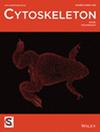封底内图
IF 1.6
4区 生物学
Q4 CELL BIOLOGY
引用次数: 0
摘要
内后盖:TGF2处理后小鼠细胞的最大投影图像。细胞核用赫斯特(洋红色)标记,丝状肌动蛋白(f -肌动蛋白)用罗丹明- phalloidin(青色至白色)染色。来源:Rylee E. King(美国特拉华大学)本文章由计算机程序翻译,如有差异,请以英文原文为准。

Inner Back Cover Image
ON THE INNER BACK COVER: Maximum projection image of mouse tenocytes treated with TGF2. Nuclei are labeled with Hoechst (magenta) and filamentous actin (F-actin) is stained with Rhodamine—Phalloidin (cyan to white).
Credit: Rylee E. King (University of Delaware, USA)
求助全文
通过发布文献求助,成功后即可免费获取论文全文。
去求助
来源期刊

Cytoskeleton
CELL BIOLOGY-
CiteScore
5.50
自引率
3.40%
发文量
24
审稿时长
6-12 weeks
期刊介绍:
Cytoskeleton focuses on all aspects of cytoskeletal research in healthy and diseased states, spanning genetic and cell biological observations, biochemical, biophysical and structural studies, mathematical modeling and theory. This includes, but is certainly not limited to, classic polymer systems of eukaryotic cells and their structural sites of attachment on membranes and organelles, as well as the bacterial cytoskeleton, the nucleoskeleton, and uncoventional polymer systems with structural/organizational roles. Cytoskeleton is published in 12 issues annually, and special issues will be dedicated to especially-active or newly-emerging areas of cytoskeletal research.
 求助内容:
求助内容: 应助结果提醒方式:
应助结果提醒方式:


